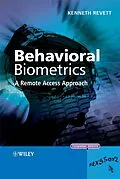With the advent of the internet as a medium for performing business
transactions, the need for a secure communication channel has never
been more paramount. The study of behavioral biometrics - the
verification and/or identification of individuals based on the way
they provide information to an authentication system - originated
from the need for a small footprint, versatile alternative to
expensive hardware-based, or physiological, biometrics. As an
emerging alternative to these traditional and more well-known
physiological biometrics such as fingerprinting or iris scans,
behavorial biometrics can offer state-of-the-art solutions to
identity management requirements as either a stand-alone system or
part of a multi-biometric security system.
Whilst there are many existing texts that focus on physiological
biometrics or algorithmic approaches deployed in biometrics,
Behavioral Biometrics addresses a gap in the existing
literature for a text that is solely dedicated to the topic of
behavioral biometrics. The author
* presents a thorough analysis of the latest research into
well-known techniques such as signature verification and voice
recognition, as well more recently developed and ground-breaking
techniques including keyboard/ mouse dynamics, gait analysis, odour
analysis and salinity testing, which are ever increasing in
reliability;
* discusses exciting future trends that focus on the
brain-computer interface using EEG technology and may one day
enable human-machine interaction via brainwave patterns;
* describes the central applications for the technology within
e-commerce and related industries, and provides a number of
comprehensive case studies of major implementations that provide
the user with a strong sense of the approaches employed in the
various subdomains of behavioral biometrics.
* provides a comprehensive glossary of terms as well as a rich
set of references and websites that enable the reader to explore
and augment topics as required.
Behavioral Biometrics will appeal to graduate and
postgraduate students, as well as researchers wishing to explore
this fascinating research topic, in areas of biometrics and
computer science including classification algorithms, pattern
recognition, artificial intelligence & security and digital
forensics. In addition, it will serve as a reference for system
integrators, CIOs, and related professionals who are charged with
implementing security features at their organization.
Autorentext
Dr Kenneth Revett is a senior lecturer at the University of Westminster. He lectures principally at post-graduate level within Biometrics, Bioinformatics, and Neuroscience and has helped to expand and re-validate the Bioemtrics, Bioinformatics and Applied Cognitive Neuroscience MSc degree programmes. He is currently actively engaged in Biometrics related research (principally behavioural bioemtrics such as keystroke dynamics, mouse dynamics, and graphical authentiation systems). He holds a patent c/o the University of Westminster for a keystroke dynamics based based authentication system (called KBD:-(Secure)). He is on the international programme committees of 20+ conferences, and the editorial board for the International Journal of Electronic Security and Digital Forensics.
Zusammenfassung
With the advent of the internet as a medium for performing business transactions, the need for a secure communication channel has never been more paramount. The study of behavioral biometrics - the verification and/or identification of individuals based on the way they provide information to an authentication system - originated from the need for a small footprint, versatile alternative to expensive hardware-based, or physiological, biometrics. As an emerging alternative to these traditional and more well-known physiological biometrics such as fingerprinting or iris scans, behavorial biometrics can offer state-of-the-art solutions to identity management requirements as either a stand-alone system or part of a multi-biometric security system.
Whilst there are many existing texts that focus on physiological biometrics or algorithmic approaches deployed in biometrics, Behavioral Biometrics addresses a gap in the existing literature for a text that is solely dedicated to the topic of behavioral biometrics. The author
- presents a thorough analysis of the latest research into well-known techniques such as signature verification and voice recognition, as well more recently developed and ground-breaking techniques including keyboard/ mouse dynamics, gait analysis, odour analysis and salinity testing, which are ever increasing in reliability;
- discusses exciting future trends that focus on the brain-computer interface using EEG technology and may one day enable human-machine interaction via brainwave patterns;
- describes the central applications for the technology within e-commerce and related industries, and provides a number of comprehensive case studies of major implementations that provide the user with a strong sense of the approaches employed in the various subdomains of behavioral biometrics.
- provides a comprehensive glossary of terms as well as a rich set of references and websites that enable the reader to explore and augment topics as required.
Behavioral Biometrics will appeal to graduate and postgraduate students, as well as researchers wishing to explore this fascinating research topic, in areas of biometrics and computer science including classification algorithms, pattern recognition, artificial intelligence & security and digital forensics. In addition, it will serve as a reference for system integrators, CIOs, and related professionals who are charged with implementing security features at their organization.
Inhalt
1. Introduction to Behavioral Biometrics.
1.1 Introduction.
1.2 Types of Behavioral Biometrics.
1.3 The Biometric Process.
1.4 Validation Issues.
1.5 Relevant Databases.
1.6 International Standards.
1.7 Conclusions.
1.8 Research Topics.
2. Voice Identification.
2.1 Introduction.
2.2 Case Studies in Speaker-Dependent Voice Recognition.
2.3 Standards.
2.4 Conclusions.
2.5 Research Topics.
3. Signature Verification.
3.1 Introduction.
3.2 Off-Line Signature Verification.
3.3 Online Signature Verification.
3.4 Signature Verification Standards.
3.5 Conclusions.
3.6 Research Topics.
4. Keystroke Dynamics..
4.1 Introduction.
4.2 Attribute Selection Process.
4.3 The Enrollment Process.
4.4 Generation of the Reference Profile.
4.5 Case Studies.
4.6 Standards.
4.7 Conclusions.
4.8 Research Topics.
5. Graphical-Based Authentication Methods..
5.1 Introduction to the Graphical Authentication Approach.
5.2 Recognition-Based Techniques.
5.3 Recall-Based Techniques.
5.4 Multi-Image Graphical Password Systems.
5.5 Conclusions.
5.6 Research Topics.
6. Mouse Dynamics..
6.1 Introduction.
6.2 Case Studies.
6.3 Conclusion.
6.4 Research Topics.
7. Multimodal Biometric Systems.
7.1 Introduction to Multimodal Biometrics.
7.2 Fusion Framework Approaches.
7.3 Case Studies.
7.4 Continuous Verification.
7.5 Standards.
7.6 Conclusions.
7.7 Research Topics.
8. The Future of Behavioral Biometrics.
8.1 Introduction to the Future of Biometrics.
8.2 Software-Only Approach.
8.3 Software plus Hardware Approach.
8.4 Conclusions.
8.…
